Field bindweed is an excellent natural remedy for many diseases. We will tell you about the properties of this plant, its use and the main contraindications. In the modern world, in the world of innovative technologies and the rapid development of industrialization, people are beginning to forget that nature is an invaluable gift that must not only be used, but also protected. After all, nature is not only the animal world, it is, first of all, the world of plants, most of which are medicinal, healing and simply irreplaceable in medicine. Many decades (or even centuries ago), people with the help of medicinal plants were saved from the most terrible and deadly ailments. The experience of healing with fruits, leaves of plants, as well as seeds and roots, has been accumulating for centuries and has come down to the present time with a huge store of knowledge about medicinal plants.
At first glance, the most common weed, with which we quite often meet, may turn out to be one of the very useful and even medicinal herbs. Unfortunately, one of these plants does not make people happy at all, because it is considered a malicious weed, which is not so easy to get rid of, it is a field bindweed. The field bindweed is a cute, delicate flower with an alluring aroma, the bells of which can have colors from pale pink to bright blue. Bindweed popularly has other names: "windbill", "bindweed", "field birch" or "bindweed". This plant is easily recognizable as it has thin stems, twisted in a spiral and curling along the ground, bushes, fences or other plants, which can sometimes reach 1.5 meters in length. The poovia has small leaves and funnel-shaped flowers on the stalks, which attract with their tenderness and pleasant aroma.
By the appearance of this plant, it is possible to determine whether it will rain during the day, if bindweed flowers are open in the morning - we are waiting for the sun, and if closed - cloudy and rainy weather. In addition to our country, dodder grows in a huge number of countries, and in each of them it has different names, but its medicinal properties do not change from this. All parts of the dodder are rich in minerals and vitamins.
There is no doubt that field bindweed is a medicinal plant, but it poses a threat to human health, especially if you do not know how and when it can be used for medicinal purposes. When fresh, the wrapper is a very poisonous plant, which is why it is necessary to know exactly how it is harvested and how to prepare it.
Procurement and storage of the roll
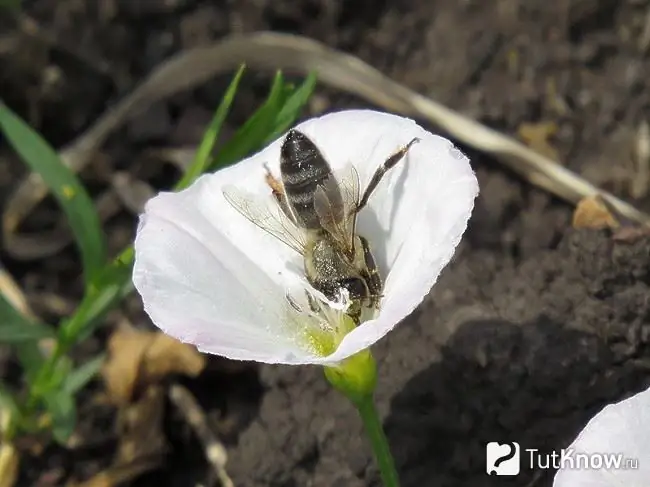
For medicinal purposes, mainly roots and shoots with leaves are used, less often seeds and flowers. The bindweed is pulled out of the ground with the roots, fresh greens are cut off from the roots, and dried separately from each other. It is best to use fresh bindweed, but due to the fact that it does not grow all year round, do not forget to harvest field bindweed for the winter.
Both roots and greens must be dried in the shade, rather than in direct sunlight, so that the plant does not lose its beneficial properties. In order for the grass not to rot and dry evenly from all sides, it is necessary to constantly turn it over and stir it. A well-dried plant and roots, must be finely chopped and placed in a vessel that is tightly closed with a lid. Medicinal herb can be stored for no more than a year, and only if it is stored in a dark place, in the future it loses all its useful properties.
Field bindweed composition
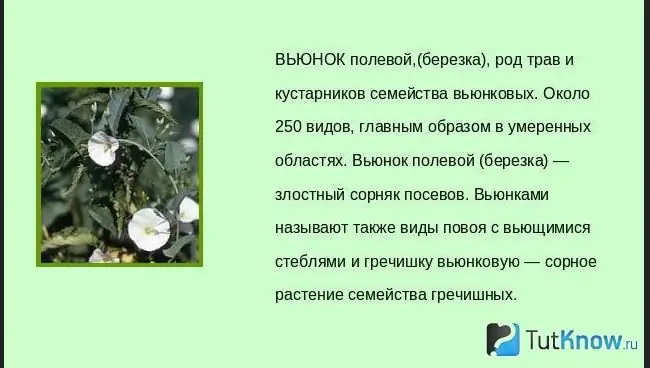
This plant is interesting because in its different parts, a different amount of nutrients, for example:
- the roots contain cholinometric compounds, up to 8% tannins and 5% resins;
- ascorbic acid is in the leaves up to 110 mg, as well as flavonoids and vitamins;
- Seeds are rich in alkaloids and fatty oil (47–48%), but this is only in a fresh plant; in a dried form, bindweed loses its nutrients almost twice.
The healing properties of the plant
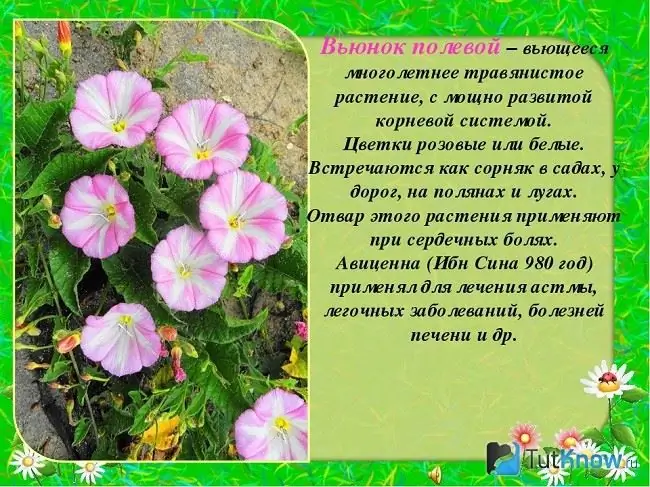
- Bindweed herb. Decoctions, teas and tinctures from the poviyka have a laxative effect on the body, and also relieve discomfort and pain after poisoning. Also, the herb of this plant has an analgesic effect on the body, in particular for: gastritis, fever, enterocolitis, toothache or menstrual pain, as well as for bruises, wounds and neuroses. Recent studies have shown that this herb is capable of causing destructive effects on malignant tumors.
- Fresh juice from leaves of field bindweed. With the addition of field bindweed juice, ointments are made that are used as an anesthetic and are capable of destroying dermatitis and dermatoses. The juice is also used as a choleretic agent, to relieve unbearable ear pains, to detoxify poisonous reptile bites, to remove freckles and soothe headaches. When mixed with vinegar, olive oil, wine or honey it becomes an excellent remedy for arthritis, ulcers, burns, wounds, and relieves swelling with ease.
- Aboveground part of the bindweed. Tibetan healers use the aerial part of this plant to relieve symptoms of fever, treat atherosclerosis, and even pulmonary tuberculosis. Mongolian healers use the birch tree to treat diseases of the throat, ears, or nose. Decoctions and infusion from this part of the plant have found their application in eliminating the symptoms of respiratory diseases, female diseases, and even chronic bronchitis.
- Roll seeds. Against long-term and persistent constipation, Korean doctors use bindweed seeds, as they affect the body, as a gentle laxative. Also, seeds help from a strong and prolonged cough, edema of various nature, nephritis, kidney or heart failure.
Based on the above, we can say that bindweed has the following medicinal properties:
- wound healing;
- antipyretic;
- anthelmintic;
- diaphoretic;
- pain reliever;
- diuretic;
- laxative;
- choleretic;
- homeostatic;
- anti-inflammatory;
- antineoplastic;
- bactericidal.
The use of field bindweed in folk medicine
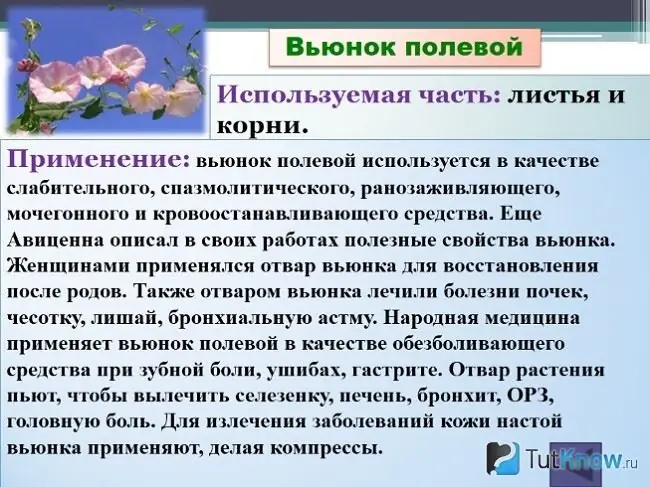
Most phyto-therapists and people who know almost everything about plants offer several recipes for various ailments, which include bindweed:
- Toothache. An infusion of bindweed helps from excruciating toothache: 1 tbsp. l. coppice roots, pour 200 ml. boiling water, the container with the roots is covered with a lid and left for 20 minutes to infuse. Then the broth is filtered through cheesecloth, and throughout the day they rinse their mouth with it, holding it for a few minutes in the direction of the aching tooth.
- Inflammation of the liver or spleen. Freshly squeezed bindweed juice is diluted in the following ratio: 200 ml. water, 2 tbsp. l. juice. The remedy is used 3 times a day, before meals, 0.25 glasses each.
- Bladder disease. Such diseases are mainly treated with herbal preparations, which include field bindweed. Such a collection can be prepared by mixing in equal parts yarrow, birch, bearberry and lingonberry leaves. Mix all the herbs together with the calculation of 2 tbsp. l. collection for 500-600 ml of boiling water, insist for two hours in a warm and dark place. After the specified time, strain the infusion and drink 3 times a day, 200 ml each.
- Intermenstrual uterine bleeding. Bindweed broth in milk: 1 tsp. 250 ml of finely chopped birch is poured. fresh milk, cooked over low heat for five minutes. The volume of the broth is divided into equal parts, and drunk per day, in four doses.
- Hard healing wounds. It is necessary to make compresses from an alcoholic tincture of bindweed. Preparation: in a 2: 1 combination, pour alcohol over the bindweed flowers. After two weeks of infusion, the tincture is poured into a glass bottle with a cap, and before use it is diluted with water (1 tablespoon per 0.5 cups of cold boiled water). Compresses or lotions are made from the resulting liquid in places of injury.
- Skin cancer. Even such a terrible disease at the initial stage will not be able to resist the healing properties of bindweed. It is necessary to mix 1: 1 homemade butter and freshly grated root of the pack, leave for 1-2 hours, then lubricate the affected skin with it.
- The problem of impotence. Dry bindweed seeds just need to be eaten raw, one 1 tsp, just once a day, until the time improves.
- Treatment of bronchitis. One Art. l. field bindweed in a crushed form is poured with 300 g of boiled water. After the expiration of half an hour of infusion, and then filtration, the resulting product is taken three times a day, 2-3 tbsp. l.
- Treating colds. Everyone knows that in order to quickly get rid of a cold, you need to sweat well, here the diaphoretic property of bindweed will help us. 1 tsp grind birch seeds and pour boiling water (200 ml.). We leave under the lid for 20 minutes, after which the potion is filtered. We take 50 g, before meals, and then we crawl under the covers.
- Atherosclerosis. We prepare a tincture for alcohol: 10 g of birch, infuse for 1 week for 50 g of alcohol. Filter the product, store in a closed container. You need to drink the tincture three times a day, 15-20 minutes before meals.
And this is far from all the recipes and tips on where and how this "miracle plant" can be used.
Contraindications to the use of field bindweed
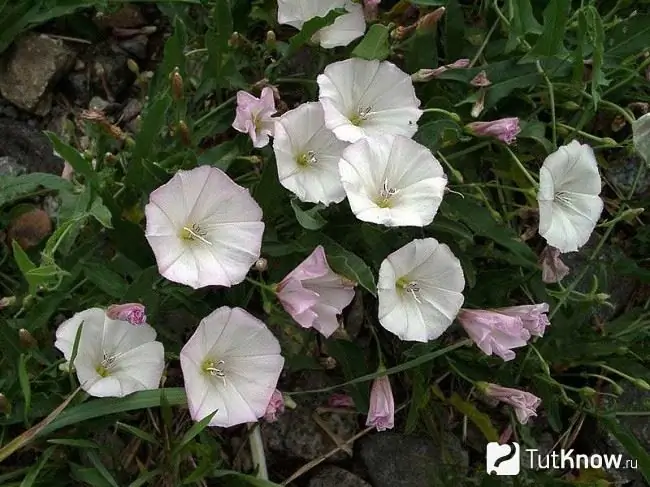
Before using a medicinal plant, always and everyone needs a doctor's consultation. There is no such thing that there are no contraindications, unfortunately, our plant also has them:
- intolerance to the substances contained in the plant;
- pregnancy or lactation;
- people with hemorrhoids problem;
- even healthy people are not recommended to take bindweed for more than 3 months in a row.
It is necessary to adhere to the dosage, an overdose will entail:
- abdominal pain, diarrhea and vomiting;
- irritation and pain in the kidneys;
- hematuria - the appearance of blood in the urine;
- paralysis of the muscles of the tongue and speech impairment;
- in pregnant women can provoke miscarriage.
"Mother Nature" gave us a lot of beauty, and most importantly, healing. One day you just need to stop, look around you, see all this. It would seem that an ordinary field weed is a pack, but how much benefit can it bring to human health. The only thing to remember is that the entire medicinal plant must be used wisely and carefully. Then you will get the maximum benefit for your health, while not helping out the pharmacy business.
You will learn more about the field bindweed and its use in medicine from this video:
[media =






